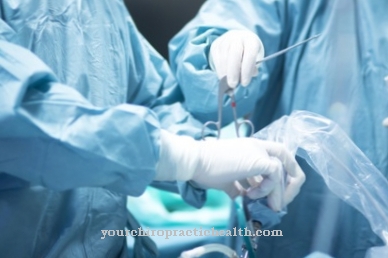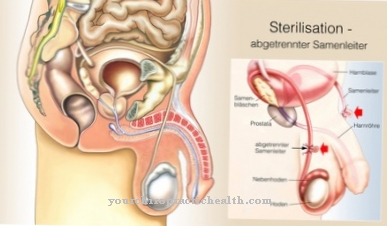Among the diseases that threaten the female breast, cancer of the breast (breast cancer, (Latin: breast cancer)) is arguably the most dangerous. Fortunately, however, both treatment outcomes and the chances of early detection of this disease have improved significantly over the past 30 years. Nevertheless, knowing your own body is still the safest protection against the spread of disease for women. From it derives the ability to recognize changes in the right direction and to differentiate between the sick and the healthy.
Incidence & Distribution of Breast Cancer

The prerequisites for this are particularly favorable with breast cancer. Because of its superficial localization, the doctor is, for example, during series examinations, but also in the practice when the woman is concerned other complaints under treatment, able to recognize breast cancer in its earliest stages with simple examination methods and to initiate appropriate treatment.
The statistical overview of the incidence of mammary gland diseases in different ages provides information that breast cancer is not just, as is often assumed, a disease of older women. Even if such cases are rare, it can occur as early as the third decade of life. It can even be assumed that breast cancer could be diagnosed even more frequently in the younger age groups if more women were to monitor themselves more carefully and the series of examinations were further intensified.
The risk of the disease increases with age. In Germany, for example, around 150 new cases are reported for every 100,000 women over the age of 50. Of the same number, 70-year-old women even register around 250 new cases each year. These figures alone make clear the need for comprehensive education about breast cancer and the possibilities that are available to every woman for "self-observation".
Symptons & Signs
The female mammary gland consists of the actual mammary gland tissue and about 15 to 20 larger mammary gland ducts that meet in the area of the nipple. The mammary gland tissue can extend into the armpit as a so-called axillary process. Between the individual lobes of the mammary gland there is more or less abundant fat tissue. Pathological processes in the area of the mammary gland can now cause certain changes that can be recognized by simply touching them. Not so seldom do they reveal themselves to the eye even more impressively than to the groping hand.
Such visible changes include: inflammation of the nipple, discharge of fluid or blood from the nipple, standing up or retraction of a nipple, skin retraction, reddening or swelling of the skin. Some women suffer from inflammation of the nipple during breastfeeding, which is often quite painful and only heals after medical treatment.
However, if such changes occur outside of the breastfeeding period and they also show no tendency to heal, a check-up for cancer is urgently required. Older women in particular, however, often trivialize such inflammation of the nipple and treat it themselves with ointments or poultices, without knowing the cancer risk. Another rather serious sign of a possible illness is fluid or blood secretion from the nipple. They indicate pathological processes within the milk ducts or in their immediate vicinity.
The normal milk secretion during the breastfeeding period is of course excluded. Diseased secretions from the nipple are yellow, brown or bloody in color. It is not that seldom that they are only noticed temporarily. Usually there is hardly any tactile finding. This is also the reason why women with such symptoms go to the doctor late. Elevation or retraction of a nipple, which can also be cancer-related, are difficult to recognize as early findings when viewed normally. They can be seen with your arms raised or your hands on your hips.
Sometimes skin retraction also occurs. Differences in the size of the breasts, with or without a wart standing up, as well as retraction of one or both nipples (so-called inverted nipples) do not necessarily have to be symptoms of the disease. They can also be inherited (hereditary). Then such deviations from the norm are mostly known to women since their youth.
In contrast to different breast sizes and retracted nipples, skin retractions are a relatively typical sign of the presence of cancer. They are caused by scar-like shrinkage of the connective tissue in the breast. If they are visible just by looking at them, it is often an advanced disease. Reddening and swelling of the skin are always an expression of an inflammatory process. Since they are very painful, the patients usually go to the doctor very quickly.
If, on the other hand, there is no pain, such changes are easily overlooked, although precisely then there is an increased suspicion of cancer and a doctor should be consulted as soon as possible. Every woman who, when touching her breast, notices lump formation and, more or less, well-defined hardening in the mammary gland, must definitely consult a doctor. They can appear alone or be accompanied by visible changes.
The changes in the mammary gland under the influence of female sex hormones are a problem in themselves. Many women observe hardening in the mammary gland one to two weeks before the monthly bleeding, which then regress again. They are related to the rhythmic process of building up and breaking down the mammary gland tissue. It cannot therefore be viewed directly as pathological, even if severe pain sometimes requires treatment.
Treatment & Therapy

Treatment outcomes for breast cancer have improved significantly over the past 30 years. Undoubtedly, intensive education of the population, new technical treatment and detection options and better diagnostics by doctors have made a significant contribution to this favorable development. At the same time, the number of cases that are recognized in the favorable early stages is increasing. Likewise, the proportion of patients with benign processes has increased considerably in the last few decades. Only about every twentieth patient who comes to a hospital because of an abnormal change in the mammary gland has breast cancer.
However, this shows that women observe themselves better, which on the other hand enables the doctor to recognize cancer in its early stages and to treat it more successfully than in previous decades. Precisely for this reason it seems all the more incomprehensible to us that some women still come to the doctor very late with an already advanced breast cancer. They then often report that they discovered the suspicious lump in the breast purely by accident, mostly while washing. It is not uncommon for this first discovery to be weeks or even months ago. Carelessness or false shame prevented her from seeing a doctor for a long time.
Significantly reduced chances of recovery and a correspondingly larger surgical intervention are the result of such irresponsible behavior towards oneself and one's family. It is precisely the superficial localization of breast cancer mentioned at the beginning that enables an extremely important and promising precautionary measure that every woman can take herself, the regular monthly self-examination. In contrast to the majority of all other types of organic cancer, pathological changes in the mammary gland, behind which cancer is sometimes hidden, can be discovered for yourself.
Self-examination & self-diagnosis
Every woman can use certain self-examination methods to help identify cancer of the mammary glands in good time so that a successful and body-friendly treatment can be initiated with certainty. Perhaps the following discussions about breast self-examination for some women may seem overly complicated. But that is only due to the fact that in recent years too little attention has been paid to the possibilities of active assistance by individuals in the early detection of breast cancer.
Our efforts today are aimed at making women familiar with the practice of self-examination, because this is the only way for her to control herself and recognize pathological changes at an early stage. Surely every woman will understand without further ado that the small effort associated with the self-examination is definitely worth it. Because the earlier a cancer is detected, the greater the chances of recovery.
The best date for the self-examination is the third or fourth day after the start of the monthly bleeding (menstrual period). At this point, the swelling of the mammary gland associated with the menstrual cycle has subsided and no longer makes it difficult to palpate the breast. Menopausal women, who have stopped bleeding monthly, are best examined every month on a set date. The self-examination begins with a close examination of the breasts in front of the mirror, followed by a thorough scanning and palpation.
When looking at it, one should concentrate on any changes in the nipples, i.e. raised or retracted breasts, bulges and contractions or reddened skin. However, it is not enough to only carry out such checks from the front. Since some changes only become visible in the profile, it is advisable to also carefully check the two side views.
Early detection & palpation

Some abnormal changes in the skin or nipples are very difficult to recognize in their early stages. However, they become visible when the breasts are brought out of their normal position. Therefore, the visual control is continued with hands firmly on the hips and arms raised above the head. In addition to the front view, a side view is also required here. Only now does one go over to scanning. All sections of the chest should be examined from the outside in. The mammary gland tissue is pressed lightly against the chest wall with a flat hand.
It is important that the left breast is always scanned with the right hand and the right breast with the left hand. With large breasts, it is sometimes difficult to reach the lower edge of the chest. In such cases, one uses the other hand and presses, bending the upper body forward, for example the left breast with the right hand against the left one underneath, and doing this in reverse order for the right breast.
Finally, it is necessary to repeat the procedure just described again in a lying position. There are certain changes in the breast tissue that can only be felt in this position. Fortunately, the vast majority of the findings discovered through self-examinations or a series of medical examinations turn out to be benign processes that can be examined further in the specialist clinic at regular intervals.
If, however, breast cancer is discovered during such a precautionary examination, it is always an early stage tumor that is still limited to the site of origin and can therefore be healed well.
In individual cases, however, a reliable diagnosis through mere visual or test results is not always possible. Therefore, microscopic examination of pieces of tissue obtained from a small incision is required. The fear of disfiguring scars is unfounded here. Such wounds usually heal without irritation. However, even if minor scars should remain from such incisions, they will be smaller and less visible than scars generally left after cosmetic surgery on the breast.
Every woman today should know that breast cancer is curable if it is recognized and treated in good time. Regular series and self-examinations increase these favorable healing prospects considerably.



























